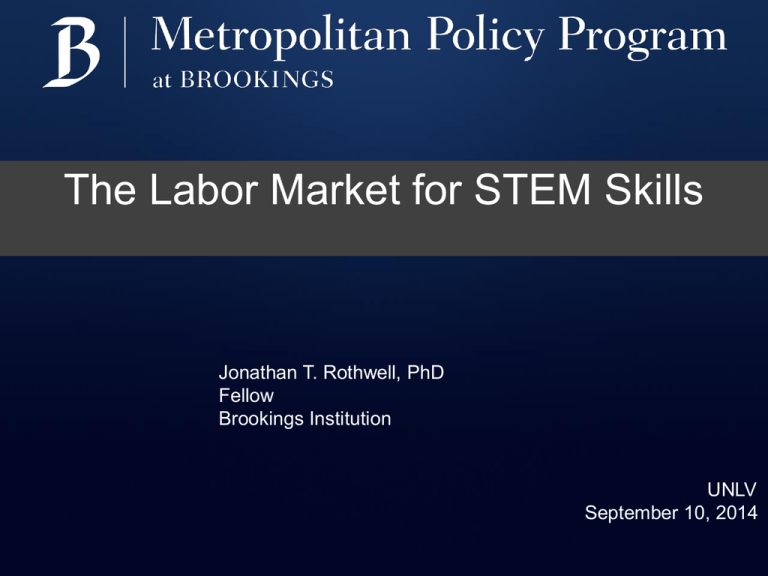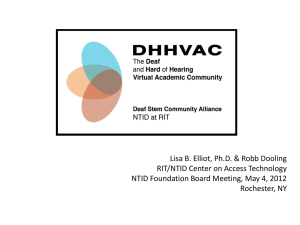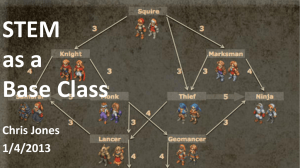
The Labor Market for STEM Skills
Jonathan T. Rothwell, PhD
Fellow
Brookings Institution
UNLV
September 10, 2014
Why does STEM matter?
1. Enhanced global, national, and regional consumer welfare
via enhanced innovation and entrepreneurship
2. Greater prosperity through higher incomes of STEM workers
and their colleagues and spending multipliers
3. Private benefits to those who acquire the skills and the
owners of companies who employ them
Defining STEM as a set of skills
What is a STEM Job?
Conventional View:
•
Definition uses no clear
standard
•
Professional jobs only
•
5% of US workforce
•
80 percent have a bachelor’s
degree or higher
How Brookings defines STEM
•
Based on O*NET survey of
worker knowledge
•
21% of US workforce
•
50 percent have a bachelor’s
degree or higher
•
Higher correlation with
wages and cognitive skill
Major Occupational Categories Sorted by STEM Score, with Share of Jobs that are STEM,
2011
High-STEM,
Percentage of
Jobs
Architecture and engineering
100%
Life, physical, and social science
87%
Healthcare practitioner and technical
76%
Computer and mathematical science
100%
Installation, maintenance, and repair
53%
Management
27%
Construction and extraction
40%
Education, training, and library
9%
Business and financial operations
42%
Farming, fishing, and forestry
8%
Production
23%
Arts, design, entertainment, sports, and media
16%
Sales and related
0%
Legal
0%
Source: The Hidden STEM Economy (Brookings Institution, 2013)
The US STEM Labor Market
The STEM Labor Market
•Long-run shortage, temporarily ameliorated by the
recession
Supply
Demand
•Weak response in supply, even as salaries have
increased
Wage Premium for STEM Skills, Controlling for
Experience, Education, and Sex, 1950-2012
25.0%
20.0%
15.0%
Standard Deviation in
Occupational STEM Skill
10.0%
5.0%
0.0%
1950 1960 1970 1980 1990 2000 2012
Analysis of data from Census Bureau via Integrated Public Use Microdata Series and O*NET. For methods, see
Jonathan Rothwell, “Hidden STEM Economy,” (Brookings Institution, 2012).
Growth in real median earnings by occupation, 2000-2013
(Source: BLS Current Population Survey)
1.10
1.08
Earnings index, 2000=1
1.06
1.04
architects and engineers
computer and math
1.02
scientists
healthcare practitioners
all occupation
1.00
0.98
0.96
0.94
2000 2001 2002 2003 2004 2005 2006 2007 2008 2009 2010 2011 2012 2013
Average salaries of software developers compared to all
other workers, in 2013 dollars
(Source: Analysis of Current Population Survey, via IPUMS)
$90,000
$80,000
$70,000
$60,000
$50,000
Software Developers
All workers
$40,000
$30,000
$20,000
$10,000
1980
1982
1984
1986
1988
1990
1992
1994
1996
1998
2000
2002
2004
2006
2008
2010
2012
$-
From 2009-2013, 3 out of every 10 jobs created on net have been in
computer and healthcare practitioner occupations
Growth rate in employment by occupation, 20092013
16.0%
14.9%
14.0%
12.0%
10.2%
10.0%
8.0%
6.0%
6.0%
4.6%
4.0%
2.0%
0.0%
USA labor force
healthcare practitioner
Source: BLS CPS
architects and engineers
computer and math workers
U.S. Hiring Difficulty Index, 3-month average
Source: Brookings analysis of JOLTS data, 2004-2014
100%
90%
80%
70%
60%
50%
40%
30%
20%
10%
0%
Apr Oct Apr Oct Apr Oct Apr Oct Apr Oct Apr Oct Apr Oct Apr Oct Apr Oct Apr Oct Apr
2004 2004 2005 2005 2006 2006 2007 2007 2008 2008 2009 2009 2010 2010 2011 2011 2012 2012 2013 2013 2014
JOLTS Hiring Difficulty Index, 3-month average
Index = job openings last month per hire this month
Percent of small businesses reporting few or no qualified
applicants, 2009 to May 2014
Source: William C. Dunkelbery and Holly Wade, "NFIB Small Business Economic Trends,"
(NFIB Research Foundation, June 2014).
50
45
40
35
30
25
20
15
10
5
0
Openings per unemployed worker, April 2014
(Source: Conference Board, HWOL)
Farming, fishing, and forestry 0.0
Construction and extraction
0.1
Personal care and service
0.2
Building and grounds cleaning and… 0.2
Production
0.2
Protective service
0.3
Food preparation and serving related
0.3
Transportation and material moving
0.4
Legal
0.4
Education, training, and library
0.4
Healthcare support
0.5
Office and administrative support
0.5
USA
0.5
Arts, design, entertainment, sports, and media
0.5
Sales and related
0.6
Life, physical, and social science
0.7
Management
0.9
Installation, maintenance, and repair
1.0
Business and financial operations
1.1
Community and social services
1.5
Architecture and engineering
Healthcare practitioners and technical
Computer and mathematical science
2.5
3.1
4.3
0.0 0.5 1.0 1.5 2.0 2.5 3.0 3.5 4.0 4.5 5.0
Median Duration
All STEM: 11 days
All Non-STEM: 5 days
Median duration of job advertisements posted in
2013-Q1 in days by STEM skill and minimum
education required
30
25
20
15
10
5
0
25
21
14
11
18
13
12
5
8
Source: “Still Searching: Job Vacancies and STEM Skills” (Brookings)
6
5
2
STEM
Non-STEM
Median duration of 2013-Q1 vacancy advertisement by occupation
(Source: Brookings analysis of Burning Glass)
18
STEM vacancies are
the hardest to fill
15
13 13
11
8
8
7
7
5
5
4
3
2
1
1
1
1
1
1
1
1
The Computer Skills Most Commonly Requested by Employers by
number of advertised vacancies in 2013
(Source: Brookings analysis of Burning Glass)
250,000
200,000
150,000
100,000
50,000
0
Regional Variation in STEM
Markets
Percentage of Advertised Vacancies in STEM Occupations for metro areas
with at least 50,000 vacancies, 2013
(Source: Brookings analysis of Burning Glass)
Average occupational hiring difficulty by regional
unemployment rate
(Source: Brookings analysis of Burning Glass and 2012 Census microdata via IPUMS)
16
13.7
14
14.3
12
10
8.5
8
7.4
Median duration of opening (days)
for occupational group
6
4
2
0
High
Moderately high Moderately low
unemployment unemployment
(<5%, >=3%)
(>10%)
(<=10%, >=5%)
Low
unemployment
(<3%)
How does the STEM labor
market look in Nevada?
Of Nevada's 20 Most Common Occupations with Vacancies Advertised in 2013,
9 are STEM jobs
Secretaries and Administrative Assistants, Except Legal,…
Registered Nurses
Sales Representatives, Wholesale and Manufacturing,…
Patient Representatives
Bookkeeping, Accounting, and Auditing Clerks
Retail Salespersons
Auditors
Software Developers, Applications
Maintenance and Repair Workers, General
Medical and Health Services Managers
Information Technology Project Managers
Computer User Support Specialists
Office Clerks, General
First-Line Supervisors of Retail Sales Workers
Informatics Nurse Specialists
Network and Computer Systems Administrators
First-Line Supervisors of Office and Administrative…
Financial Managers, Branch or Department
Sales Managers
Web Developers
0
2,000
4,000
6,000
8,000
10,000
12,000
In Nevada’s professional level STEM economy, relatively low
demand is met with even lower supply
Demand
Share of total openings
typically requiring
bachelor’s degree or
higher in STEM
occupations (2013)
versus STEM degree
attainment for
population 25 and older
(2012), Las Vegas MSA,
24.4%
Supply
16.9%
Vacancies requiring
bachelor's degree and
STEM
STEM bachelor's
degree attainment rate
Source: Brookings analysis of 2013Q4
Burning Glass data, O*NET, and 2012
American Community Survey
8.6%
6.2%
Nevada
USA
STEM jobs in Nevada pay higher salaries at high and low levels of
education
$83,925
Wages of STEM and
non-STEM jobs by
educational
requirements of
occupations,
Nevada, 2013
$56,584
$57,923
STEM
Non-STEM
$32,743
Source: Brookings analysis of
Bureau of Labor Statistics OES data
and O*NET
Bachelor's or higher
Sub-bachelor's level
STEM workers in Nevada experience lower unemployment
at both high and mid levels of educational attainment
9.5%
2012
Unemployment
Rate in Nevada
by STEM status
of Occupation and
Level of
Education
6.5%
6.3%
STEM occupation
4.0%
Non-STEM
occupation
(Source: Analysis of 2012 American
Community Survey via IPUMS and
O*NET)
Bachelor's degree or Some college or
higher
associate's degree
Median duration of vacancies in Las Vegas for major occupations,
2013-Q1
(Source: Brookings analysis of Burning Glass data, 2013-Q1
Life, physical, and social science
Education, training, and library
Architecture and engineering
Computer and mathematical science
Management
Sales and related
Healthcare practitioner and technical
Community and social services
Farming, fishing, and forestry
Business and financial operations
Installation, maintenance, and repair
Food preparation and serving related
Legal
Construction and extraction
Transportation and material moving
Building and grounds cleaning and maintenance
Protective service
Office and administrative support
Production
Arts, design, entertainment, sports, and media
Personal care and service
Healthcare support
0
5
10
15
20
25
2012 Unemployment by Occupation in Nevada vs the United States
Source: 2012 American Community Survey via IPUMS
Construction and Extraction
Nevada
USA
Transportation and Material Moving
Production
Arts, Design, Entertainment,…
Office and Administrative Support
Food Preparation and Serving…
Sales and Related
Computer and Mathematical
Legal
Installation, Maintenance, and Repair
Business and Financial Operations
Computer workers
have relatively high
unemployment in NV,
but other STEM
professionals have the
lowest unemployment
rates in the state
Building and Grounds Cleaning and…
Management
Life, Physical, and Social Science
Architecture and Engineering
Healthcare Practitioners and…
0.0%
5.0% 10.0% 15.0% 20.0% 25.0%
Unemployment Rates of Computer Occupations in Nevada with at
Least 1000 Workers in 2012
(Source: 2012 American Community Survey via IPUMS)
30%
25%
24%
20%
15%
10%
10%
8%
4%
5%
0%
4%
5%
0%
Network and
Software
Web Developers
Computer
Computer
Computer
Developers,
Occupations, All Scientists and
Systems
Applications and
Other
Systems
Administrators
Systems
Analysts
Software
Computer
Support
Specialists
Computer
Programmers
Computer jobs advertised in Las Vegas require easier-to-find skills
than those advertised in most metropolitan areas
Mean advertisement duration in days of average skill requested in
computer occupations advertised in 100 metropolitan areas with most
vacancies, 2013
(Source: Brookings analysis of Burning Glass data)
San Jose, 44.2
Boulder CO, 41.4
Las Vegas, 39.8
Honolulu,
38.1
The Supply Problem
1987: Majors by field for STEM and non-STEM (Source: NSF)
Science
Technologies; 105;
0%
Engineering Agriculture Science;
technologies; 19,138; 5,355; 1%
Engineering; 74,423;
2%
7%
Computer sciences;
39,927; 4%
Math; 16,515; 2%
Biology; 39,047; 4%
Physical Sciences;
20,155; 2%
Health Professions;
64,399; 6%
Non-STEM,
724,468, 72%
2012: Majors by field for STEM and non-STEM (Source: NSF)
Science
Technologies;
568; 0%
Engineering
technologies;
16,040; 1%
Agriculture Science;
Engineering; 82,197;
16,365; 1%
5%
Computer
sciences; 41,745;
2% Math; 18,838; 1%
Biology; 96,912; 6%
Physical Sciences;
26,347; 1%
Health Professions;
152,734; 9%
Non-STEM,
1,288,267, 74%
Engaging young women in STEM can help narrow the STEM gap
in Nevada
80%
65%
56%
Female share of
bachelor’s degree
holders by STEM
field, ages 18 to 30,
Nevada, 2010-2012
Source: Brookings analysis of
2010-2012 American Community
Survey via IPUMS
31%
21%
Engineering
Computer and
Information
Sciences
Mathematics Biology and Life Medical and
and Statistics
Sciences
Health Sciences
and Services
Closing the STEM opportunity gap will also require elevating STEM
completion rates for under-represented young populations, especially African
Americans and Latinos
STEM bachelor’s
degree attainment
by field versus
population share,
by race/ethnicity,
18-30 year-olds,
Nevada, 20102012
45%
46%
47%
64%
57%
87%
Source: Brookings analysis of
2010-2012 American
Community Survey via IPUMS
15%
14%
33%
9%
4%
10%
16%
8%
2%
32%
18%
19%
Engineering
Biology and
Life Sciences
8%
Population
share
Computer and
Information
Sciences
6%
0%
30%
13%
Mathematics
and Statistics
Medical and
Health
Sciences and
Services
white
latino
black
asian
Why don’t more people get
STEM training?
1. Success in STEM depends on knowledge acquired as a child. High wage
premiums for STEM degree holders don’t make parents and teachers
better at teaching STEM subjects or children more committed to learning
them
2. Switch-out rates are extremely high and correlated with math experience
and skill, suggesting inadequate K-12 prep and higher-ed resources
3. Cultural and social barriers prevent many women, blacks, and Latinos from
pursuing a STEM degree
How to boost STEM Skills
The to-do list
Who Needs to do it
1)
Enrich infant/toddler home life
1) Non-profits; state & local governments
2)
Improve pre-K to 10th grade quality
across the board
2) Non-profits; state & local governments
3)
Allow students to take post-secondary
level classes during last two years of
high school
3) Non-profits; state & local governments
4)
Lower cost of college and adopt best
practices in retention and completion
in higher-education
4) Governments, non-profits and Higher
Ed via innovation, tuition support,
tutoring, and mentoring
5)
Expand access to adult training &
improve curriculum alignment with
demand
5) Governments; Colleges; Businesses
via philanthropic investments,
apprenticeships, internships, and onthe-job training
38
For more information
Email:
Jonathan Rothwell
jrothwell@brookings.edu
Visit:
www.brookings.edu/metro
Hidden STEM Economy
http://www.brookings.edu/research/reports/2013/06/10-stem-economyrothwell
Still Searching : Job Vacancies and STEM Skills
http://www.brookings.edu/research/interactives/2014/job-vacancies-andstem-skills#/M10420









